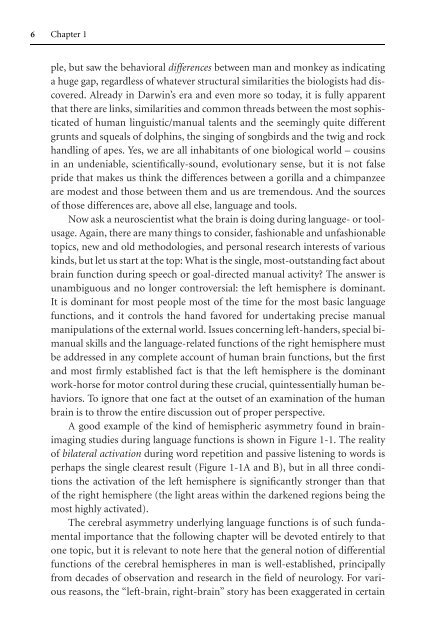Tone of Voice and Mind : The Connections between Intonation ...
Tone of Voice and Mind : The Connections between Intonation ...
Tone of Voice and Mind : The Connections between Intonation ...
You also want an ePaper? Increase the reach of your titles
YUMPU automatically turns print PDFs into web optimized ePapers that Google loves.
6 Chapter 1<br />
ple, but saw the behavioral differences <strong>between</strong> man <strong>and</strong> monkey as indicating<br />
a huge gap, regardless <strong>of</strong> whatever structural similarities the biologists had discovered.<br />
Already in Darwin’s era <strong>and</strong> even more so today, it is fully apparent<br />
that there are links, similarities <strong>and</strong> common threads <strong>between</strong> the most sophisticated<br />
<strong>of</strong> human linguistic/manual talents <strong>and</strong> the seemingly quite different<br />
grunts <strong>and</strong> squeals <strong>of</strong> dolphins, the singing <strong>of</strong> songbirds <strong>and</strong> the twig <strong>and</strong> rock<br />
h<strong>and</strong>ling <strong>of</strong> apes. Yes, we are all inhabitants <strong>of</strong> one biological world – cousins<br />
in an undeniable, scientifically-sound, evolutionary sense, but it is not false<br />
pride that makes us think the differences <strong>between</strong> a gorilla <strong>and</strong> a chimpanzee<br />
are modest <strong>and</strong> those <strong>between</strong> them <strong>and</strong> us are tremendous. And the sources<br />
<strong>of</strong> those differences are, above all else, language <strong>and</strong> tools.<br />
Now ask a neuroscientist what the brain is doing during language- or toolusage.<br />
Again, there are many things to consider, fashionable <strong>and</strong> unfashionable<br />
topics, new <strong>and</strong> old methodologies, <strong>and</strong> personal research interests <strong>of</strong> various<br />
kinds, but let us start at the top: What is the single, most-outst<strong>and</strong>ing fact about<br />
brain function during speech or goal-directed manual activity? <strong>The</strong> answer is<br />
unambiguous <strong>and</strong> no longer controversial: the left hemisphere is dominant.<br />
It is dominant for most people most <strong>of</strong> the time for the most basic language<br />
functions, <strong>and</strong> it controls the h<strong>and</strong> favored for undertaking precise manual<br />
manipulations <strong>of</strong> the external world. Issues concerning left-h<strong>and</strong>ers, special bimanual<br />
skills <strong>and</strong> the language-related functions <strong>of</strong> the right hemisphere must<br />
be addressed in any complete account <strong>of</strong> human brain functions, but the first<br />
<strong>and</strong> most firmly established fact is that the left hemisphere is the dominant<br />
work-horse for motor control during these crucial, quintessentially human behaviors.<br />
To ignore that one fact at the outset <strong>of</strong> an examination <strong>of</strong> the human<br />
brain is to throw the entire discussion out <strong>of</strong> proper perspective.<br />
A good example <strong>of</strong> the kind <strong>of</strong> hemispheric asymmetry found in brainimaging<br />
studies during language functions is shown in Figure 1-1. <strong>The</strong> reality<br />
<strong>of</strong> bilateral activation during word repetition <strong>and</strong> passive listening to words is<br />
perhaps the single clearest result (Figure 1-1A <strong>and</strong> B), but in all three conditions<br />
the activation <strong>of</strong> the left hemisphere is significantly stronger than that<br />
<strong>of</strong> the right hemisphere (the light areas within the darkened regions being the<br />
most highly activated).<br />
<strong>The</strong> cerebral asymmetry underlying language functions is <strong>of</strong> such fundamental<br />
importance that the following chapter will be devoted entirely to that<br />
one topic, but it is relevant to note here that the general notion <strong>of</strong> differential<br />
functions <strong>of</strong> the cerebral hemispheres in man is well-established, principally<br />
from decades <strong>of</strong> observation <strong>and</strong> research in the field <strong>of</strong> neurology. For various<br />
reasons, the “left-brain, right-brain” story has been exaggerated in certain


